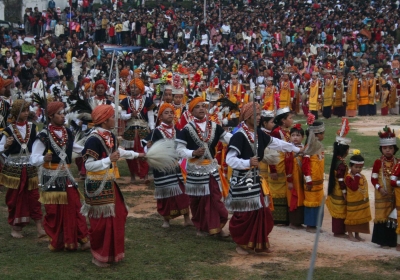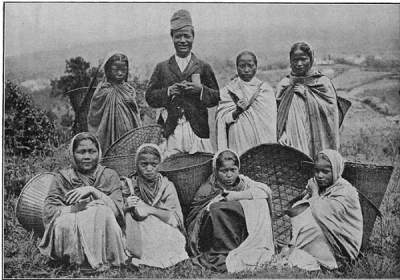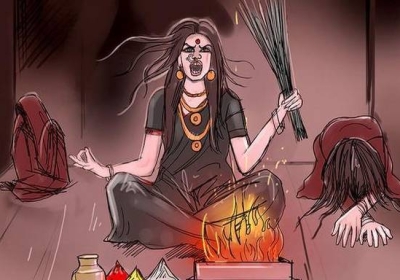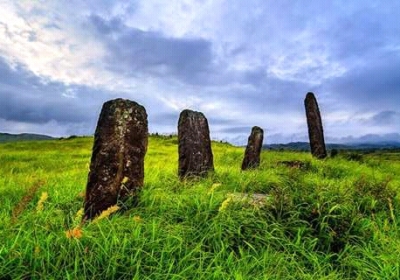Khasi Heritage: Festival of Creatures

The special aptitude of human beings over other creatures has manifested in several encounters, but some creatures are still jealous or envious of human beings. The animals endeavour to imitate human beings by organising a dance festival of all creatures. The tiger is the chief supervisor of the festival and is entrusted with assigning the specific role of every creature according to their proficiency in their respective expertise. The folk announcer or Sangot, was sent across the universe to inform everybody about the festive occasion and requested them to attend in their colourful attire and respective instruments for performances at the dance festival of all creatures. Every animal shares their individual skills in each of their performances in rhythm with the dance performed primarily by the owl as the female dancer and the raccoon as the male dancer, including other creatures. It is interesting to note that the raccoon is among the prominent dancers because of his demonstration to swinging his sword, which is sparkling everywhere while he shakes his hands to the extent that the thunder wanted to borrow. Initially, the raccoon hesitated to share his sword with the thunder, because he had been preparing for weeks for the festival. However, when he was tired and wanted to relax for a while, the thunder insisted that he lend him the sword for a brief moment, and the raccoon could not deny but to reluctantly agree with so much apprehension. Instantly, the thunder was swinging the sword and dancing randomly throughout the arena. The speculation about the thunder was not unfounded, because he was so excited that he completely ignored the spectators and other dancers, and indiscriminately strode all around the ground, disrupting the harmonious participation of other graceful dancers. Suddenly, thunder swung the sword so violently that the reflection of the polished sword glittered like lightning and he ascended to the sky and never returned again to the festival. A pall of gloom descended upon the ground and dusk was about to occur, when the sun and the moon arrived together and danced while the other dancers were already perturbed by the strange incident. For some creatures, the strange behaviour of thunder does not attract attention as much as the pair of latecomers who performed very affectionately. Subsequently, some of the creatures passed indecent and sarcastic remarks to the sun and the moon because of their passionate involvement in the rhythm of music, as they were not aware of the weird conduct of the thunder.
When the sun overheard the harsh comments, she immediately left the dancing arena and disappeared behind the horizon, and the moon merged with the twilight. Actually, the sun and the moon were late because both of them had to ensure that sufficient light was shone on the surface of the earth so that every participant would enjoy the merriment during the day and relish their experience when they returned home in the evening. However, certain creatures overlooked their concerns and made casual remarks, which hurt the sentiment of the two siblings. From that moment, the dark night continues in the subsequent days, to the astonishment of every creature. The phenomenon was serious because it has affected everybody and every life is threatened by the lack of sunlight. A search operation was conducted and discovered that the Mother-Sun had sneaked into the cavern called ‘Krem Lamet Latang’. The sun hides in the cave because she could not bear the insults perpetrated by some of the creatures and when the waning season of the moon occurred, it became more difficult for everybody. Therefore, a divine assembly was held again to persuade the sun to perform her routine duty and different creatures have diverse opinions. The elephant was huge and strong, stout and majestic that any creature would dare to challenge him, and he was conceited about it with the reaction of others. The elephant confidently declared before the congregation that he would volunteer to drag the sun out of the cave and promised to be back soon. The elephant vehemently tried to enter the cave with force, but did not succeed and the furious sun threw a cylinder at his forehead as a lesson and it was stuck permanently. The fearsome elephant went back to the congregation with humiliation and reported about his failed attempt to impose his strength on the Mother-Sun, and since then, he learned to be gentle and carry a trunk on his forehead till today. The congregation was puzzled by the incident and appealed for an alternative solution. All the strong animals would not even think of it, if the gigantic creature like the elephant had surrendered. Then, the hornbill appeared before the congregation and boast that he will lure the sun with his handsome appearance and was sure to succeed as he flew off for his mission. When the hornbill reached the entrance of the cave, he crashed in without a request and tried to entice the sun. The enraged Mother-Sun took a piece of log and threw on the forehead of the hornbill. The poor bird was hurt and hurled out of the cave with shame, only to fly back to the congregation with a report of another failure. The charming hornbill could not impress the Mother-Sun and fled away in disgrace by carrying an appendage on his beak and a hoarse voice for the rest of his life. The congregation realised that the force of strength and charm of beauty are not the forte of the Mother-Sun, and the entire creatures were surprised and scared of any further attempt. Then the divine assembly invokes an incantation to find out if anybody had disappeared from the assembly, because strict instructions had already commanded the entire creature to attend without fail. Somebody informed that there was a trivial creature without any essence and had the nature of a worthless parasite. The hawk, was sent everywhere to see if any creature was absent from the congregation, including the mentioned creature, and was ordered to summon them irrespective of their significance.
Hoi Kiw! Ka Shad Laiphew Mrad
La sdang sa ka pihuiñ, la shong khet sa ka leh meng;
Ki mrad ki la sdang skuiñ, ka shad rong ba shu tynneng.
Ka shad ki laiphewmrad, ha lympung te ba kyndeh;
Kynshnet ki kjat ki krad, khalalek ki kti kaweh.
Ka sngi ka poi dier por, ha lympung ka shad kynjai;
Kynthoh kyntien pohdor, para jingthaw ba ym khuslai.
Iasnoh te shipara, ka meingi bad te bad u bnai;
Jynthaw kynnoh kynta, la burom ba khlem tyngkai.
Ki khor ki khriam deipor, jah burom ha lympung shad
Tyngkreiñ ba khlem akor, ka ïamrem te ba la mad .
Bitar te ka Meingi, ha lympung te jah burom;
La poi te ka pali, ban phet rieh da ka jingdom.
U kui ha lympung shad, u mastieh kaweh waitlam;
ka wait knieh u pyrthat, sha suiñ u her kloi lan u pam.
Phliak phliak thaba leilieh, lyoh ha suiñ ba ki byrthen;
la kut ka shad mastieh, khie wahleng pyrthat ha bneng.
Ïamrem te ka Meingi, ba laplah laiphew jingthaw;
La poi apot sepsngi, la ha lum ne la ha khlaw.
Sha krem lamet latang, la phet rieh te ka meingi;
Dum tliw pyrthei mariang, sah lyngngoh te synñia sngi.







